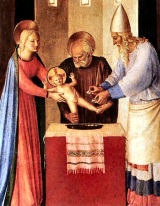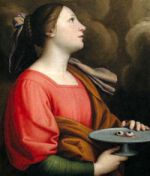Catholic Activity: Reflections on the Feast of the Presentation

Father Pius Parsch presents wonderful food for thought on this feast of Candlemas.
DIRECTIONS
1. Reflections on the Feast. The liturgy brings to our attention a number of truths that deserve special consideration.
a) Several Old Testament prophets had foretold how the temple's greatest glory was reserved for the day when the Messiah appeared in its sacred precincts and revealed Himself. Their oracles are now fulfilled. Today Jesus enters His Father's house for the first time; in future years He will often manifest Himself there as the Messiah and the Son of God. Considerable prominence is given this truth; see, for example, the Introit, Gradual, and Epistle. And the temple of old typified the Church.
b) Today the Infant Savior is brought to the temple and offered to God. According to Mosaic Law every male firstborn was "holy to the Lord"; he was to be brought to the temple and "redeemed" by an offering. In our Lord's case the act assumed a deeper significance. God does not give His Son away gratis; His presentation at Mary's hands constituted, we may say, the Offertory of His life. If we align Christ's redemptive life with the Mass, His presentation in the temple would be the Offertory, His death on the Cross the consecration and elevation. Today the divine Lamb lies on the paten of sacrifice and is offered to the Father. Thirty-three years hence He will complete the act by dying on the Cross. Yes, this day commemorates the oblation of Christ's whole redemptive work, not excluding the offertory oblations of all believers.
c) Today our Blessed Mother offers her purificatory sacrifice as required by Mosaic Law (Leviticus). Actually Mary was not bound by the precept, for she was the purest of virgins, and her Son the spotless Lamb of God. Nevertheless, with humility and with a true spirit of sacrifice she brought the offering of the poor, a pair of doves. In imitation and in remembrance of her holy act, the Church commends to mothers a very laudable practice. I refer to the liturgical blessing given to mothers after childbirth (Churching of Women). As soon as the mother has recuperated, she comes to church with her babe. She thanks God for the successful delivery and offers her beloved infant to the Lord; and the priest blesses both. The object of the blessing is not purification, as in the Old Testament — Christian mothers have no need of purification after childbirth. But Mary's humility is recognized and imitated by the new mother as she waits in the rear of the church, and from there follows the priest to the altar.
d) A very noble figure, the aged Simeon! Through many, many years he had desired the Messiah's coming. Now with the unquestioning faith of a child, he adores Israel's hope in a workman's needy Child. His glowing love causes him to feel young again as he takes the Infant in his arms. There is nothing more he wants from life. Having seen the Redeemer, he is overcome with gratitude and pours out from his soul the night prayer of his life: "Now, Lord, you may dismiss Your servant in peace."
His beautiful canticle, the Nunc Dimittis, has been incorporated into the Church's official night prayer (Compline), where it serves as an expression of thanksgiving for the graces and blessings of another day of redemption. As we sing it we see Simeon holding the Child Jesus in his arms and then, with grateful heart, retiring from his earthly service to God. We, too, are in the Lord's service. At the close of day we hold the Savior in our arms, mystically speaking; we hold Him in faith, in grace, in the sacraments, especially the Sacrament of the Altar. Fervently we thank God for His blessings; and we are prepared, if it be His will, to take our leave from the world. Yes, Lord, now You may dismiss me, Your servant. For with the eyes of faith I have again seen my Savior, Jesus. I, too, belong to the multitude of the elect. Christ is my salvation, my redemption, my Light; He enlightens the darkness of my mind and heart. He is my glory, my eternal recompense! Oh, that we could bring each day to a close with thoughts like these ! How well they express the noblest sentiments of a Christian heart at the end of day. How beautiful would Simeon's prayer fall from the lips of the dying; it would be the night prayer to life.
2. A Christmas Remembrance. Candlemas marks the closing of the Christmas cycle. [Editor's Note: In the revised calendar, the closing of the Christmas season is at the Baptism of Our Lord, not Candlemas.] In remembrance of the divine gifts bestowed by the Christmas mystery, the Church gives us a candle. The candle's message is that we always retain Emmanuel, i.e., "God with us." God is with us in three ways. The Church indicates them by handing us a candle and requesting us to hold it at the Gospel and during the Canon, and to take it home after the service. Her action shows how we possess Christ (a) in the word of God, principally in the Gospel; (b) in the Eucharist; and (c) in grace. Aren't these wonderful Christmas gifts?
a) The word of God. Too many Christians have no true appreciation of God's word. To them it is a source of instruction and edification, of reassurance and admonition; but nothing more. They do not realize the sacramental power inherent in the divine word, or that this power is its highest endowment. In a sacrament God comes and brings grace. By His word God also comes and brings grace. God's word is a seed bursting with life. Still, it is not a magic power. It produces its effect only in hearts with suitable soil. Human cooperation is always needed.
b) That the Eucharist brings Christ everyone accepts. What is perhaps not so well understood is how the Eucharist sustains and increases supernatural life in the soul. Christ's flesh is the manna that nourishes us on this earthly journey; it is the seed of glory and the pledge of resurrection.
c) The candle we receive today betokens our baptismal candle. The Church presupposes that we will use it, lighting it piously on various occasions. For this reason she gives us a new one each year. She likewise presupposes that we have not forgotten what she told us at baptism: "Receive this lighted candle, and keep your baptism above reproach. Keep the commandments of God, so that when the Lord comes to His marriage feast you may meet Him in the halls of heaven with all His saints, and may live with Him forever." Yes, the candle received on Candlemas Day ought be a reminder of our baptismal grace, of Christ in us, Emmanuel. On earth there is no way of coming closer to Him. Only in heaven will we be nearer.
Activity Source: Church's Year of Grace, Volumes 1-5 by Dr. Pius Parsch, The Liturgical Press, Collegeville, Minnesota, 1964






